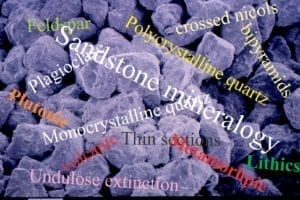Identifying detrital lithic fragments
This post is part of the How To… series
See also the companion post: Lithic grains in thin section: Avoiding ambiguity
Lithic fragments are the bits of eroded or broken rock that can’t be easily slotted into either the quartz or feldspar classification end-members. They are the fragments that are not broken down into single minerals. They tend to be fine-grained and rather dirty looking in shades of brown and grey. In thin section they are nowhere near as exciting to look at as other framework grains. But If we want to know something about sediment source rocks (provenance) or the longevity and survival of granular sediment during transport and deposition, then lithics are no less valuable than quartz, feldspar – perhaps more so.
R.H. Dott’s classification divides the lithic end-member into sedimentary, volcanic, and metamorphic clasts; R.L. Folk takes each of these a step further (I’m not convinced Folk’s subdivision is practical). Part of the problem with too fine a subdivision is the diagenetic and mechanical alteration that lithics are prone to, rendering them indeterminate. Lithic fragments are much softer and chemically more reactive than their quartz-feldspar counterparts during burial diagenesis. Continue reading


